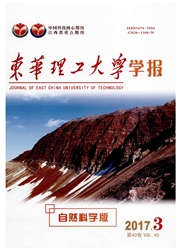

 中文摘要:
中文摘要:
针对日益突出的环境问题,磁学方法依靠自身便捷、经济等一系列优势在环境污染研究方面得到了广泛的应用。文章总结了环境研究中磁性矿物的特征和鉴别方法及主要的环境磁学参数,回顾了磁学方法在地表沉积物污染、水环境污染和大气环境污染方面的应用进展。并指出增进对磁性物质与污染源关系、污染物磁性形成机理的理解,加强从单纯的磁化率测量到多磁性参数的综合运用以及与矿物学、地球化学等方法的结合来查明污染物质的多源性、记录环境信息在时空尺度上的不确定性和不同环境对污染物承载能力的差异性,是提高磁学方法在环境污染研究领域应用效果的关键,有利于使环境污染监测和评价由定性研究向定量化研究发展。
 英文摘要:
英文摘要:
In view of existing increasingly prominent environmental issues, magnetic methods have been w;dely used in environmental pollution studies relying on their own a series of convenience and economic advantages. It is mainly the use of magnetic measurements to identify the nature and concentration of Fe-containing minerals in environmental materials, which is an ideal tool to understand the process which human activities impact on the regional and urban environment, and to undertake the modern environmental monitoring, tracing of pollution sources, as well as reconstruction of the history of environmental pollution. The article sums up the characteristics and identification methods of the magnetic minerals in environmental pollution studies and the main parameters of environmental magnetism, and casts back the main advances made in such fields as earth surface sediments pollution ,water environment pollution and atmospheric pollution. Meanwhile, The article points out due to the uncertainty of records of environmental information in time and space scales and the environment pollutants varied from place to place resulted in by more pollution-derived substances, for enhancing the application of magnetic methods in environmental pollution research, some work should be done, such as strengthening of studying the relationship between the magnetic minerals and the sources of pollution, reinforcing of studying magnetic mechanism of contaminants, intensifying of the comprehensive application of more magnetic parameters from a purely magnetic susceptibility measurements to, enhancing of studying comprehensively of magnetic methods with the mineralogy and geochemistry methods, and making environmental pollution monitoring and evaluation developed from quantitative to qualitative research.
 同期刊论文项目
同期刊论文项目
 同项目期刊论文
同项目期刊论文
 Palynological evidence for vegetational and climatic changes from the HQ deep drilling core in Yunna
Palynological evidence for vegetational and climatic changes from the HQ deep drilling core in Yunna AC magnetic susceptibility studies of Chinese red clay sediments between 4.8 and 4.1 Ma: Paleoceanog
AC magnetic susceptibility studies of Chinese red clay sediments between 4.8 and 4.1 Ma: Paleoceanog IMPACT OF LAND USE AND LAND COVER CHANGE ON ENVIRONMENTAL DEGRADATION IN LAKE QINGHAI WATERSHED, NOR
IMPACT OF LAND USE AND LAND COVER CHANGE ON ENVIRONMENTAL DEGRADATION IN LAKE QINGHAI WATERSHED, NOR Holocene precipitation and temperature variations in the East Asian
monsoonal margin from pollen dat
Holocene precipitation and temperature variations in the East Asian
monsoonal margin from pollen dat Lake surface fluctuations since the late glaciation at Lake Daihai, North central China: A direct in
Lake surface fluctuations since the late glaciation at Lake Daihai, North central China: A direct in Constraints of authigenic carbonates on trace elements (Sr, Mg) of lacustrine ostracod shells in pal
Constraints of authigenic carbonates on trace elements (Sr, Mg) of lacustrine ostracod shells in pal Holocene precipitation and temperature variations in the East Asian monsoonal margin from pollen dat
Holocene precipitation and temperature variations in the East Asian monsoonal margin from pollen dat Multi-proxy evidence for Late Pleistocene-Holocene climatic and environmental changes in Lop-Nur Xin
Multi-proxy evidence for Late Pleistocene-Holocene climatic and environmental changes in Lop-Nur Xin Seasonal Variations and Evidence for the Effectiveness of Pollution Controls on Water-Soluble Inorga
Seasonal Variations and Evidence for the Effectiveness of Pollution Controls on Water-Soluble Inorga Oxygen isotope fractionation in the ostracod Eucypris mareotica: results from a culture experiment a
Oxygen isotope fractionation in the ostracod Eucypris mareotica: results from a culture experiment a Holocene climate changes in the mid-high latitude monsoon margin reflected by the pollen record from
Holocene climate changes in the mid-high latitude monsoon margin reflected by the pollen record from Climate implications of major geochemical elements in the Holocene sediments of the North and East C
Climate implications of major geochemical elements in the Holocene sediments of the North and East C Weathering, Sr fluxes, and controls on water chemistry in the Lake Qinghai catchment, NE Tibetan Pla
Weathering, Sr fluxes, and controls on water chemistry in the Lake Qinghai catchment, NE Tibetan Pla Temporal trends and variability of daily maximum and minimum, extreme temperature events, and growin
Temporal trends and variability of daily maximum and minimum, extreme temperature events, and growin Holocene vegetation characteristics of the southern Loess Plateau in the Weihe River valley in China
Holocene vegetation characteristics of the southern Loess Plateau in the Weihe River valley in China Geochronology of a surface core in the northern basin of Lake Qinghai: Evidence from 210Pb and 137Cs
Geochronology of a surface core in the northern basin of Lake Qinghai: Evidence from 210Pb and 137Cs Contribution of inherent organic carbon to the bulk δ13C signal in loess deposits from the arid west
Contribution of inherent organic carbon to the bulk δ13C signal in loess deposits from the arid west Abrupt shifts in the Indian monsoon during the Pliocene marked by high-resolution terrestrial record
Abrupt shifts in the Indian monsoon during the Pliocene marked by high-resolution terrestrial record Variation of airborne bacteria and fungi at Emperor Qin's Terra-Cotta Museum, Xi'an, China, during t
Variation of airborne bacteria and fungi at Emperor Qin's Terra-Cotta Museum, Xi'an, China, during t 期刊信息
期刊信息
